Business Analytics Discussion: Applying Stats to Gun Control Debate
VerifiedAdded on 2022/10/11
|5
|1074
|15
Discussion Board Post
AI Summary
This discussion post analyzes the article "Does Gun Control Reduce Violent Crime?" by Kleck, Kovandzic, and Bellows (2016). The student examines the central question of the article, which explores the relationship between gun control and violent crime rates in the United States. The post details the methodology used, including the double log model and the data collection process, emphasizing the use of state-level data and regression analysis. The student highlights the article's focus on controlling for time-varying factors and the use of quantitative methods to forecast gun violence. The discussion aligns with the assignment brief's requirement to apply statistical analysis to current events, specifically discussing how hypothesis testing and regression can be used to evaluate the impact of gun control laws on crime rates. The student also addresses the importance of managing gun ownership and the challenges associated with ambiguous gun control strictness.
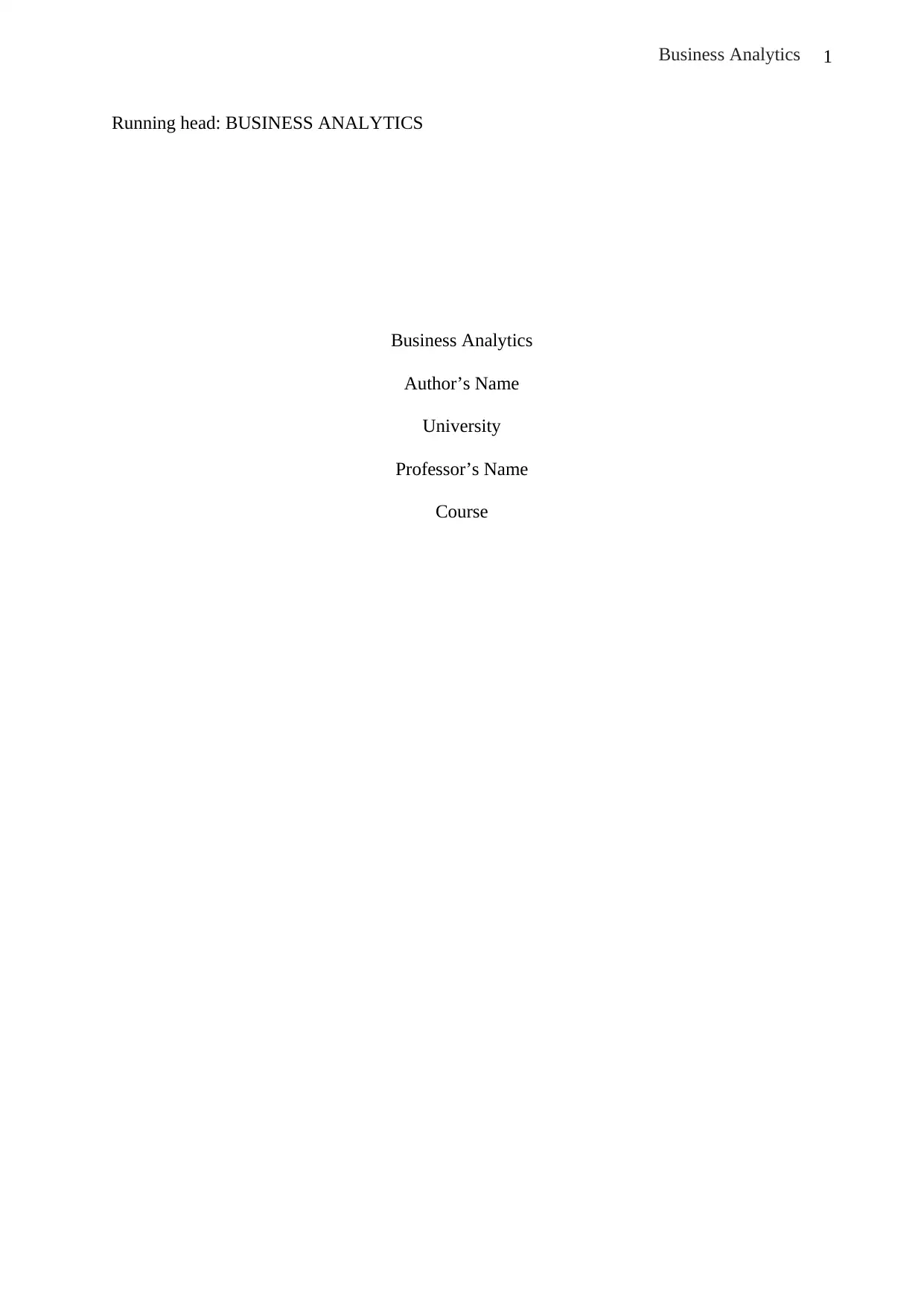
1Business Analytics
Running head: BUSINESS ANALYTICS
Business Analytics
Author’s Name
University
Professor’s Name
Course
Running head: BUSINESS ANALYTICS
Business Analytics
Author’s Name
University
Professor’s Name
Course
Paraphrase This Document
Need a fresh take? Get an instant paraphrase of this document with our AI Paraphraser
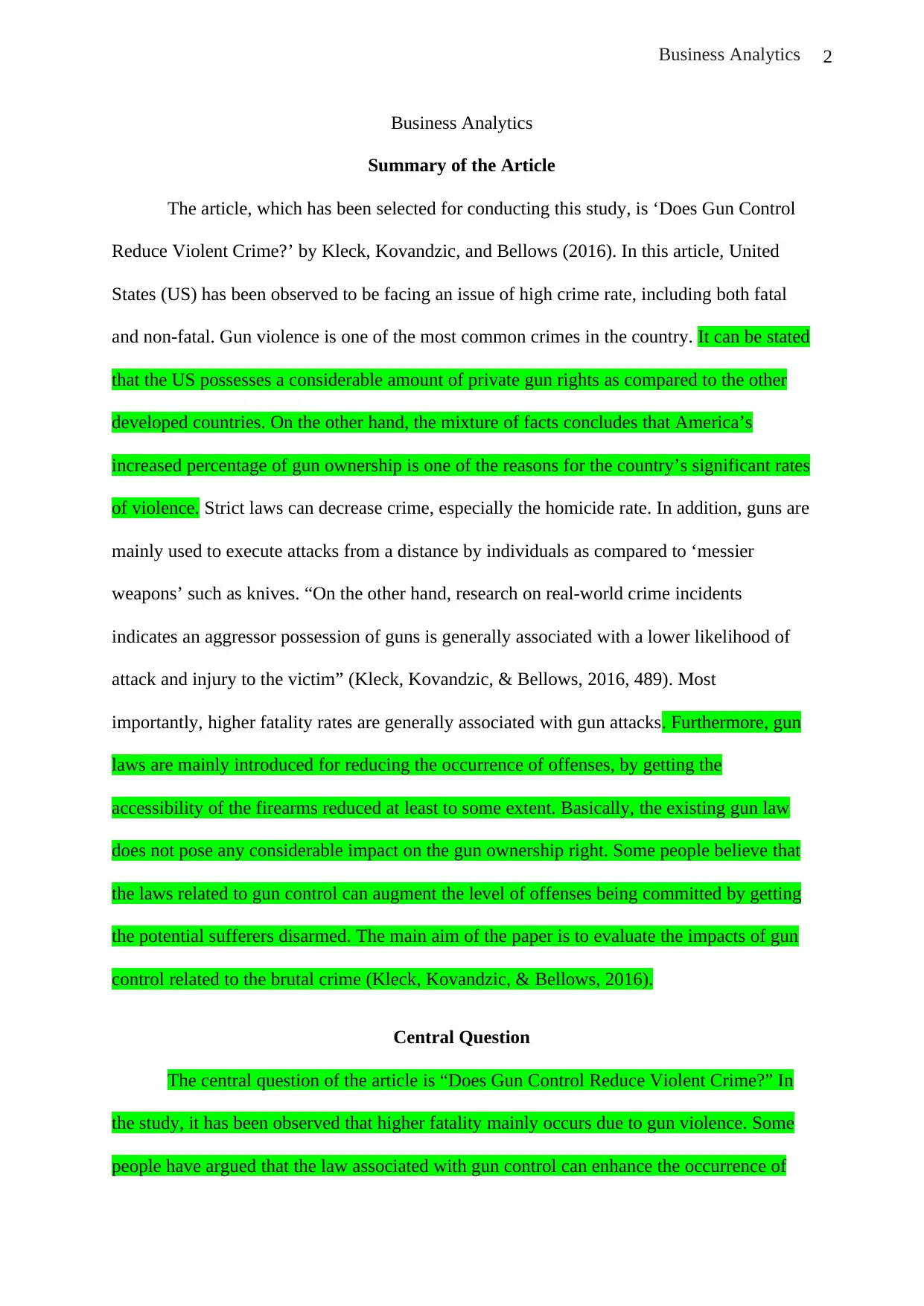
2Business Analytics
Business Analytics
Summary of the Article
The article, which has been selected for conducting this study, is ‘Does Gun Control
Reduce Violent Crime?’ by Kleck, Kovandzic, and Bellows (2016). In this article, United
States (US) has been observed to be facing an issue of high crime rate, including both fatal
and non-fatal. Gun violence is one of the most common crimes in the country. It can be stated
that the US possesses a considerable amount of private gun rights as compared to the other
developed countries. On the other hand, the mixture of facts concludes that America’s
increased percentage of gun ownership is one of the reasons for the country’s significant rates
of violence. Strict laws can decrease crime, especially the homicide rate. In addition, guns are
mainly used to execute attacks from a distance by individuals as compared to ‘messier
weapons’ such as knives. “On the other hand, research on real-world crime incidents
indicates an aggressor possession of guns is generally associated with a lower likelihood of
attack and injury to the victim” (Kleck, Kovandzic, & Bellows, 2016, 489). Most
importantly, higher fatality rates are generally associated with gun attacks. Furthermore, gun
laws are mainly introduced for reducing the occurrence of offenses, by getting the
accessibility of the firearms reduced at least to some extent. Basically, the existing gun law
does not pose any considerable impact on the gun ownership right. Some people believe that
the laws related to gun control can augment the level of offenses being committed by getting
the potential sufferers disarmed. The main aim of the paper is to evaluate the impacts of gun
control related to the brutal crime (Kleck, Kovandzic, & Bellows, 2016).
Central Question
The central question of the article is “Does Gun Control Reduce Violent Crime?” In
the study, it has been observed that higher fatality mainly occurs due to gun violence. Some
people have argued that the law associated with gun control can enhance the occurrence of
Business Analytics
Summary of the Article
The article, which has been selected for conducting this study, is ‘Does Gun Control
Reduce Violent Crime?’ by Kleck, Kovandzic, and Bellows (2016). In this article, United
States (US) has been observed to be facing an issue of high crime rate, including both fatal
and non-fatal. Gun violence is one of the most common crimes in the country. It can be stated
that the US possesses a considerable amount of private gun rights as compared to the other
developed countries. On the other hand, the mixture of facts concludes that America’s
increased percentage of gun ownership is one of the reasons for the country’s significant rates
of violence. Strict laws can decrease crime, especially the homicide rate. In addition, guns are
mainly used to execute attacks from a distance by individuals as compared to ‘messier
weapons’ such as knives. “On the other hand, research on real-world crime incidents
indicates an aggressor possession of guns is generally associated with a lower likelihood of
attack and injury to the victim” (Kleck, Kovandzic, & Bellows, 2016, 489). Most
importantly, higher fatality rates are generally associated with gun attacks. Furthermore, gun
laws are mainly introduced for reducing the occurrence of offenses, by getting the
accessibility of the firearms reduced at least to some extent. Basically, the existing gun law
does not pose any considerable impact on the gun ownership right. Some people believe that
the laws related to gun control can augment the level of offenses being committed by getting
the potential sufferers disarmed. The main aim of the paper is to evaluate the impacts of gun
control related to the brutal crime (Kleck, Kovandzic, & Bellows, 2016).
Central Question
The central question of the article is “Does Gun Control Reduce Violent Crime?” In
the study, it has been observed that higher fatality mainly occurs due to gun violence. Some
people have argued that the law associated with gun control can enhance the occurrence of
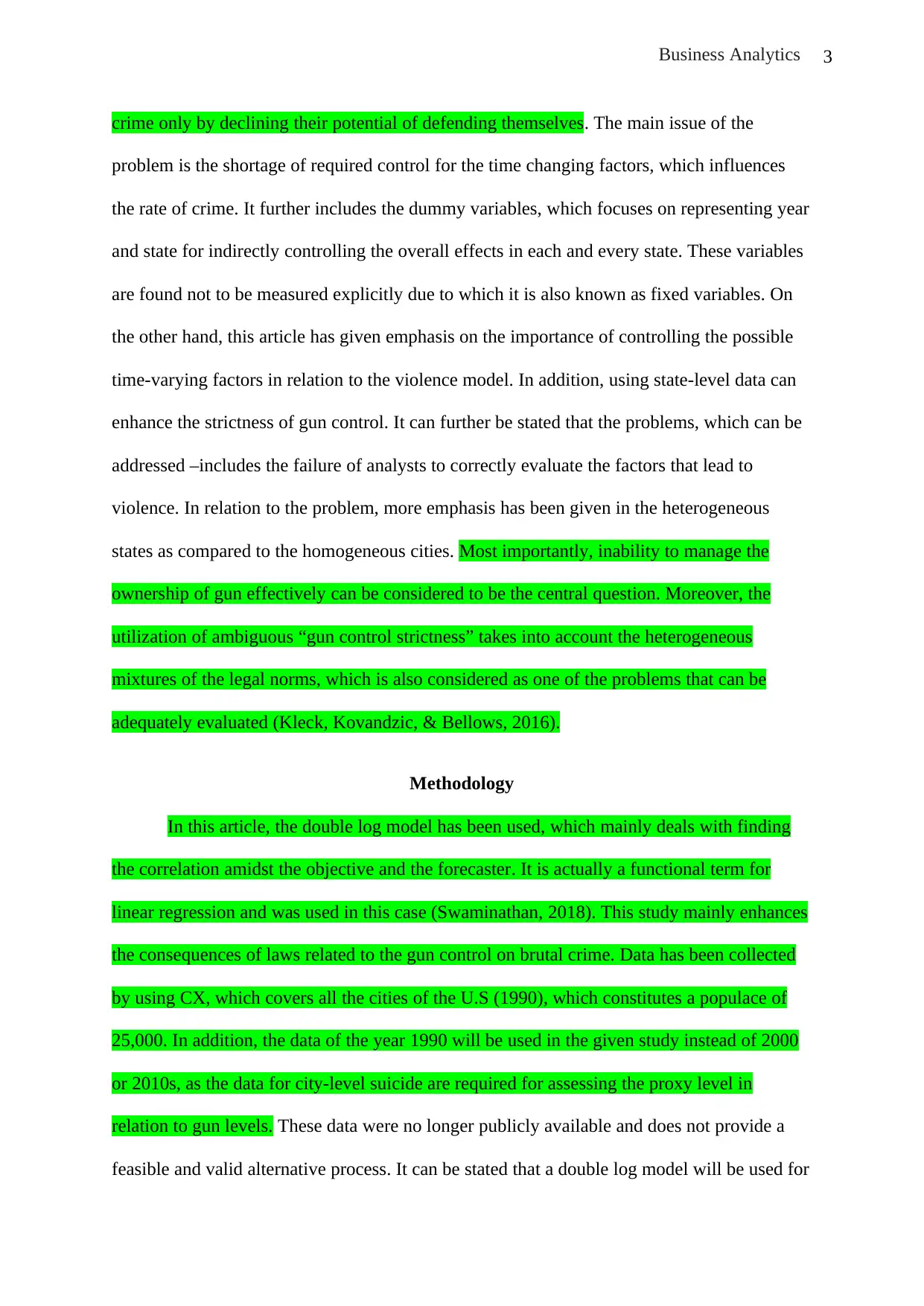
3Business Analytics
crime only by declining their potential of defending themselves. The main issue of the
problem is the shortage of required control for the time changing factors, which influences
the rate of crime. It further includes the dummy variables, which focuses on representing year
and state for indirectly controlling the overall effects in each and every state. These variables
are found not to be measured explicitly due to which it is also known as fixed variables. On
the other hand, this article has given emphasis on the importance of controlling the possible
time-varying factors in relation to the violence model. In addition, using state-level data can
enhance the strictness of gun control. It can further be stated that the problems, which can be
addressed –includes the failure of analysts to correctly evaluate the factors that lead to
violence. In relation to the problem, more emphasis has been given in the heterogeneous
states as compared to the homogeneous cities. Most importantly, inability to manage the
ownership of gun effectively can be considered to be the central question. Moreover, the
utilization of ambiguous “gun control strictness” takes into account the heterogeneous
mixtures of the legal norms, which is also considered as one of the problems that can be
adequately evaluated (Kleck, Kovandzic, & Bellows, 2016).
Methodology
In this article, the double log model has been used, which mainly deals with finding
the correlation amidst the objective and the forecaster. It is actually a functional term for
linear regression and was used in this case (Swaminathan, 2018). This study mainly enhances
the consequences of laws related to the gun control on brutal crime. Data has been collected
by using CX, which covers all the cities of the U.S (1990), which constitutes a populace of
25,000. In addition, the data of the year 1990 will be used in the given study instead of 2000
or 2010s, as the data for city-level suicide are required for assessing the proxy level in
relation to gun levels. These data were no longer publicly available and does not provide a
feasible and valid alternative process. It can be stated that a double log model will be used for
crime only by declining their potential of defending themselves. The main issue of the
problem is the shortage of required control for the time changing factors, which influences
the rate of crime. It further includes the dummy variables, which focuses on representing year
and state for indirectly controlling the overall effects in each and every state. These variables
are found not to be measured explicitly due to which it is also known as fixed variables. On
the other hand, this article has given emphasis on the importance of controlling the possible
time-varying factors in relation to the violence model. In addition, using state-level data can
enhance the strictness of gun control. It can further be stated that the problems, which can be
addressed –includes the failure of analysts to correctly evaluate the factors that lead to
violence. In relation to the problem, more emphasis has been given in the heterogeneous
states as compared to the homogeneous cities. Most importantly, inability to manage the
ownership of gun effectively can be considered to be the central question. Moreover, the
utilization of ambiguous “gun control strictness” takes into account the heterogeneous
mixtures of the legal norms, which is also considered as one of the problems that can be
adequately evaluated (Kleck, Kovandzic, & Bellows, 2016).
Methodology
In this article, the double log model has been used, which mainly deals with finding
the correlation amidst the objective and the forecaster. It is actually a functional term for
linear regression and was used in this case (Swaminathan, 2018). This study mainly enhances
the consequences of laws related to the gun control on brutal crime. Data has been collected
by using CX, which covers all the cities of the U.S (1990), which constitutes a populace of
25,000. In addition, the data of the year 1990 will be used in the given study instead of 2000
or 2010s, as the data for city-level suicide are required for assessing the proxy level in
relation to gun levels. These data were no longer publicly available and does not provide a
feasible and valid alternative process. It can be stated that a double log model will be used for
⊘ This is a preview!⊘
Do you want full access?
Subscribe today to unlock all pages.

Trusted by 1+ million students worldwide
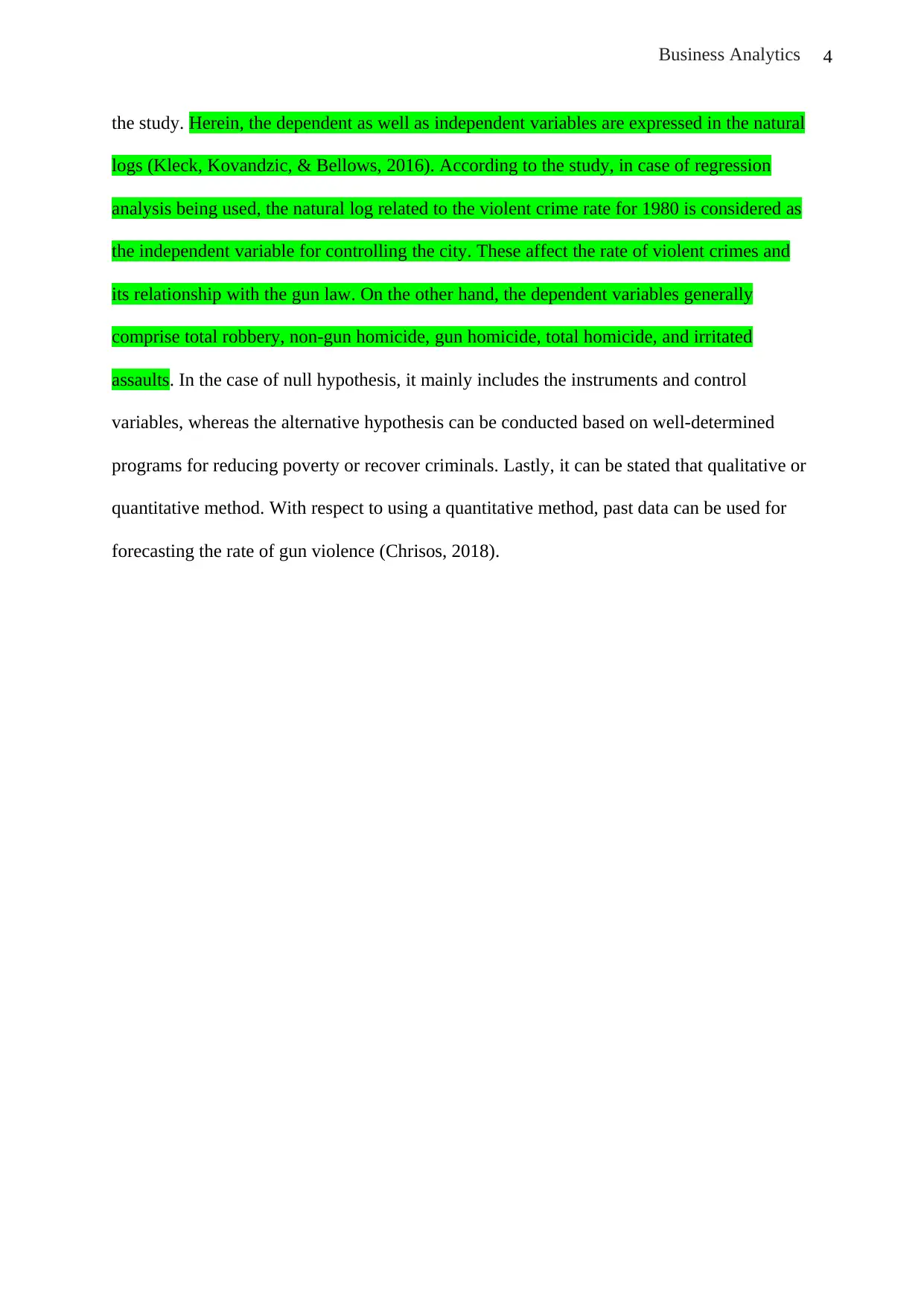
4Business Analytics
the study. Herein, the dependent as well as independent variables are expressed in the natural
logs (Kleck, Kovandzic, & Bellows, 2016). According to the study, in case of regression
analysis being used, the natural log related to the violent crime rate for 1980 is considered as
the independent variable for controlling the city. These affect the rate of violent crimes and
its relationship with the gun law. On the other hand, the dependent variables generally
comprise total robbery, non-gun homicide, gun homicide, total homicide, and irritated
assaults. In the case of null hypothesis, it mainly includes the instruments and control
variables, whereas the alternative hypothesis can be conducted based on well-determined
programs for reducing poverty or recover criminals. Lastly, it can be stated that qualitative or
quantitative method. With respect to using a quantitative method, past data can be used for
forecasting the rate of gun violence (Chrisos, 2018).
the study. Herein, the dependent as well as independent variables are expressed in the natural
logs (Kleck, Kovandzic, & Bellows, 2016). According to the study, in case of regression
analysis being used, the natural log related to the violent crime rate for 1980 is considered as
the independent variable for controlling the city. These affect the rate of violent crimes and
its relationship with the gun law. On the other hand, the dependent variables generally
comprise total robbery, non-gun homicide, gun homicide, total homicide, and irritated
assaults. In the case of null hypothesis, it mainly includes the instruments and control
variables, whereas the alternative hypothesis can be conducted based on well-determined
programs for reducing poverty or recover criminals. Lastly, it can be stated that qualitative or
quantitative method. With respect to using a quantitative method, past data can be used for
forecasting the rate of gun violence (Chrisos, 2018).
Paraphrase This Document
Need a fresh take? Get an instant paraphrase of this document with our AI Paraphraser
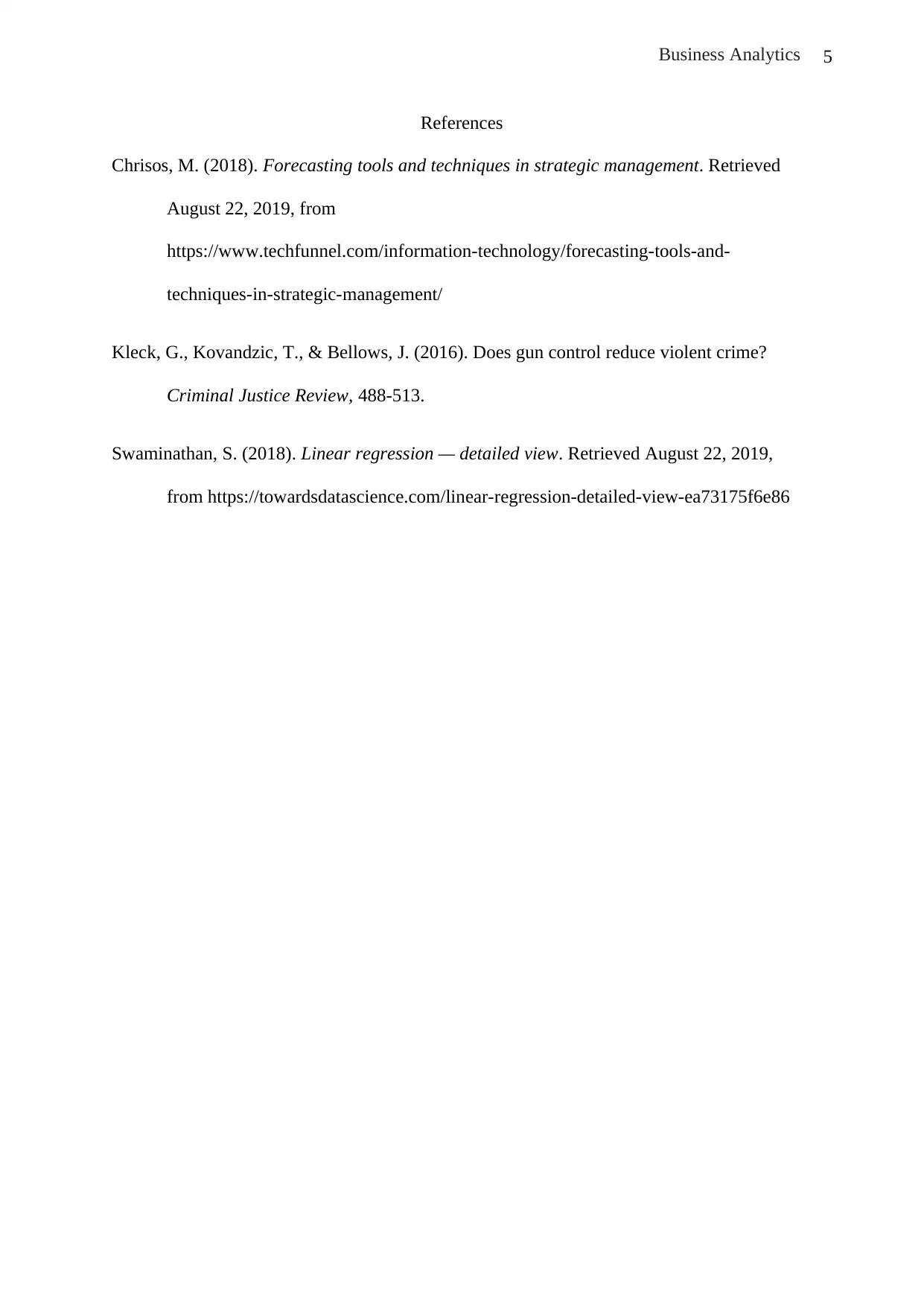
5Business Analytics
References
Chrisos, M. (2018). Forecasting tools and techniques in strategic management. Retrieved
August 22, 2019, from
https://www.techfunnel.com/information-technology/forecasting-tools-and-
techniques-in-strategic-management/
Kleck, G., Kovandzic, T., & Bellows, J. (2016). Does gun control reduce violent crime?
Criminal Justice Review, 488-513.
Swaminathan, S. (2018). Linear regression — detailed view. Retrieved August 22, 2019,
from https://towardsdatascience.com/linear-regression-detailed-view-ea73175f6e86
References
Chrisos, M. (2018). Forecasting tools and techniques in strategic management. Retrieved
August 22, 2019, from
https://www.techfunnel.com/information-technology/forecasting-tools-and-
techniques-in-strategic-management/
Kleck, G., Kovandzic, T., & Bellows, J. (2016). Does gun control reduce violent crime?
Criminal Justice Review, 488-513.
Swaminathan, S. (2018). Linear regression — detailed view. Retrieved August 22, 2019,
from https://towardsdatascience.com/linear-regression-detailed-view-ea73175f6e86
1 out of 5
Related Documents
Your All-in-One AI-Powered Toolkit for Academic Success.
+13062052269
info@desklib.com
Available 24*7 on WhatsApp / Email
![[object Object]](/_next/static/media/star-bottom.7253800d.svg)
Unlock your academic potential
Copyright © 2020–2025 A2Z Services. All Rights Reserved. Developed and managed by ZUCOL.




